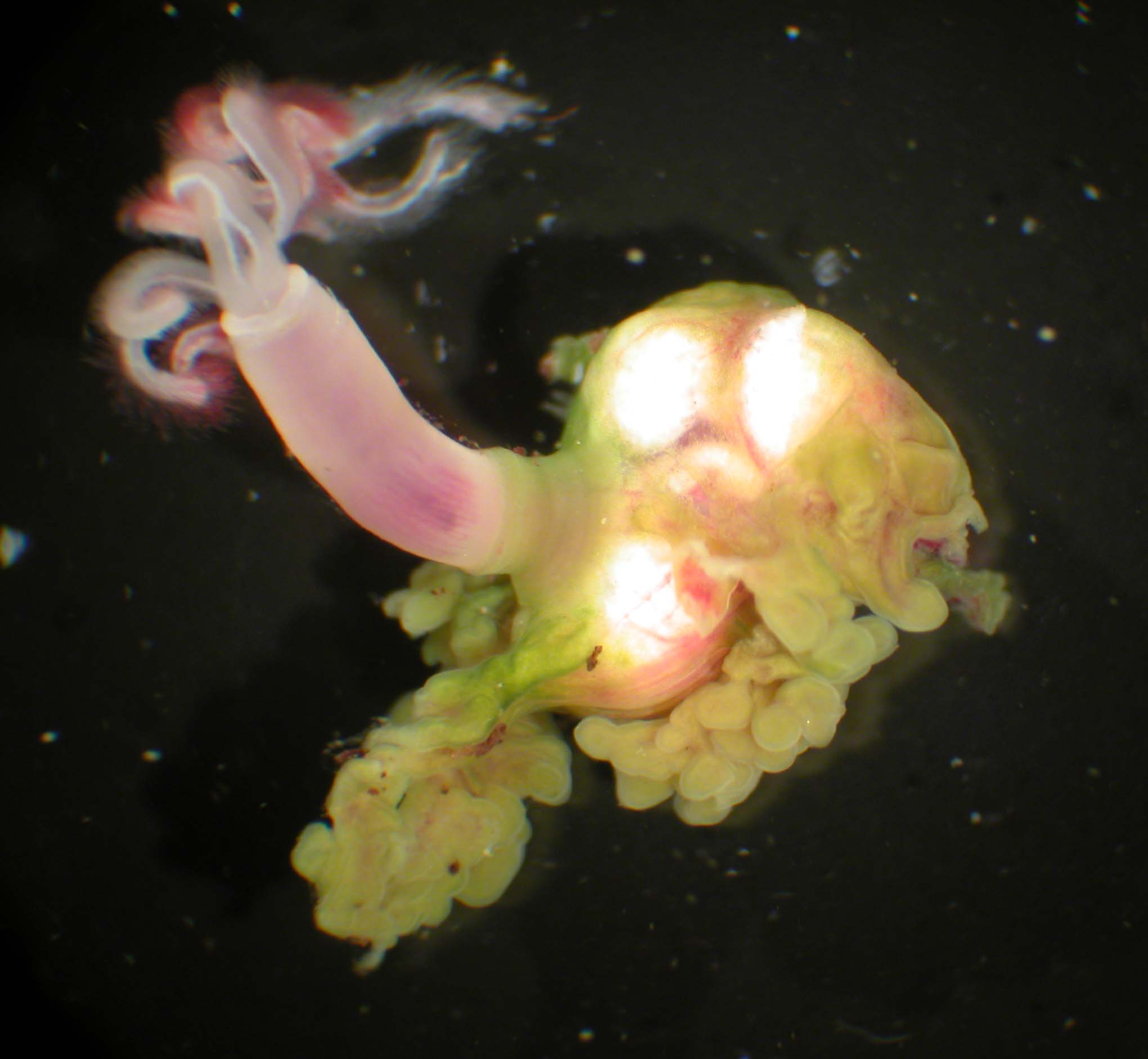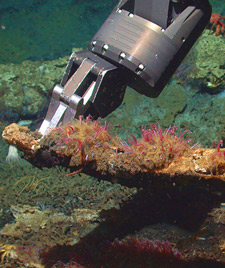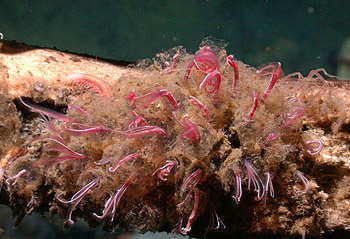Geotimes

Untitled Document

Web Extra
Thursday, August 5, 2004
Whale-bone-eating worms
 In Monterey Bay, off the coast
of California, researchers have discovered a group of extraordinary marine worms
that feed on the bones of dead whales. Even Jules Verne would have difficulty
imagining up these creatures whose closest relative may be the tubeworms found
at deep-sea vents.
In Monterey Bay, off the coast
of California, researchers have discovered a group of extraordinary marine worms
that feed on the bones of dead whales. Even Jules Verne would have difficulty
imagining up these creatures whose closest relative may be the tubeworms found
at deep-sea vents.
On whale bones, only the pinkish trunk of this cross-section of a female Osedax
tubeworm is visible. The white blobs are ovaries where more than 100 dwarf male
tubeworms can live inside the female. Symbiotic bacteria give the tubeworm's
roots their greenish color. Image copyright of Greg Rouse, 2003.
In this week's Science, Greg Rouse, a marine biologist
at the University of Adelaide in Australia, and others created a new genus,
Osedax, which translates as "bone devouring," to classify
the new organisms. Upon discovery, the researchers noticed the bone-eating worms
"shared some characteristics with the tubeworms at deep-sea vents,"
says Bob Vrijenhoek, a senior scientist at the Monterey Bay Aquarium Research
Institute and co-author of the paper. "But beyond that, we really didn't
know how they were related." Subsequent DNA testing revealed the two worms
are distant cousins. "It was probably in excess of 100 million years ago
the two groups spilt apart," Vrijenhoek says.
In 1977, scientists first discovered that entire ecosystems exist at the ocean
bottom along deep-sea vents and hydrocarbon seeps. Prior to that discovery,
scientists thought life could not exist without sunlight. Symbiotic bacteria
that live within the tubeworms process inorganic materials like sulfides or
methane and provide nutrients to the worms and surrounding communities. The
newly discovered tubeworms contain a type of bacteria that break down fats (a
type of hydrocarbon) inside of bones. "They are like termites, with symbiotic
bacteria in their guts, but they eat bone instead of wood," Vrijenhoek
says.
 Apart from the use of symbiotic bacteria
and the absence of a mouth or gut, the two tubeworms are not very similar. "They
are relatively closely related but morphologically very distinct," Rouse
says. The tubeworms found at deep-sea vents can grow up to 10 feet in height,
but Osedax are only a few inches tall. Another major difference between
the tubeworms is the presence of roots. Many of the larger tubeworms have a
single root to help anchor them to the seafloor, however, Osedax has
roots "a lot like a tree," says Ken Halanych, a marine biologist at
Auburn University, who is not associated with the research. The root penetrates
the bone and "branches out and grows several different roots," he
says. The bone-digesting bacteria reside in these roots.
Apart from the use of symbiotic bacteria
and the absence of a mouth or gut, the two tubeworms are not very similar. "They
are relatively closely related but morphologically very distinct," Rouse
says. The tubeworms found at deep-sea vents can grow up to 10 feet in height,
but Osedax are only a few inches tall. Another major difference between
the tubeworms is the presence of roots. Many of the larger tubeworms have a
single root to help anchor them to the seafloor, however, Osedax has
roots "a lot like a tree," says Ken Halanych, a marine biologist at
Auburn University, who is not associated with the research. The root penetrates
the bone and "branches out and grows several different roots," he
says. The bone-digesting bacteria reside in these roots.
The Tiburon, operated by the Monterey Bay Aquarium Research Institute,
grabs the rib of a grey whale from the ocean floor. The red filaments on the
bone are the newly discovered tubeworm. Image copyright of MBARI,
2003.
Also, unlike tubeworms at deep-sea vents, Osedax is sexually dimorphic.
"In other tubeworms, males and females look similar; in these worms, the
males are microscopic," Halanych says. The so-called dwarf males, sometimes
numbering over 100, live inside the female tubeworms, next to their oviducts.
"This is a classic textbook example of bizarre marine invertebrate anatomy,"
says Cindy Van Dover, a marine biologist at the College of William and Mary
in Williamsburg, Va., and the first female pilot for the Alvin research
submarine.
 The researchers who discovered the new tubeworms
used an unmanned, remotely operated vehicle, Tiburon. The scientists
watched TV screens on the boat while Tiburon scuttled along the seafloor
more than 9,000 feet below. They were studying clams that day and found the
whale bones and new tubeworms by coincidence. When the whale carcass came into
view, it looked "like a thick red carpet covering the bones," Vrijenhoek
says.
The researchers who discovered the new tubeworms
used an unmanned, remotely operated vehicle, Tiburon. The scientists
watched TV screens on the boat while Tiburon scuttled along the seafloor
more than 9,000 feet below. They were studying clams that day and found the
whale bones and new tubeworms by coincidence. When the whale carcass came into
view, it looked "like a thick red carpet covering the bones," Vrijenhoek
says.
Bacteria in the roots of Osedax
produce nutrients by processing the fats and lipids in the bones of whales.
Image copyright of MBARI, 2003.
The accidental discovery of the new organisms in the deep ocean underscores
the possibility for breakthroughs in understanding the deep ocean. "It
is very clear we still don't know a lot about the oceans," Halanych says.
"And this [Monterey Bay] is one of the best studied areas of the ocean
we have."
Jay Chapman
Geotimes Intern
Links:
"Worms
discovered living on whale bones," Associated Press story on CNN.com
The
Monterey Bay Aquarium Research Institute
Science - "Osedax: Bone-Eating Marine Worms with Dwarf Males"
Back to top
Untitled Document

 In Monterey Bay, off the coast
of California, researchers have discovered a group of extraordinary marine worms
that feed on the bones of dead whales. Even Jules Verne would have difficulty
imagining up these creatures whose closest relative may be the tubeworms found
at deep-sea vents.
In Monterey Bay, off the coast
of California, researchers have discovered a group of extraordinary marine worms
that feed on the bones of dead whales. Even Jules Verne would have difficulty
imagining up these creatures whose closest relative may be the tubeworms found
at deep-sea vents. 
 Apart from the use of symbiotic bacteria
and the absence of a mouth or gut, the two tubeworms are not very similar. "They
are relatively closely related but morphologically very distinct," Rouse
says. The tubeworms found at deep-sea vents can grow up to 10 feet in height,
but Osedax are only a few inches tall. Another major difference between
the tubeworms is the presence of roots. Many of the larger tubeworms have a
single root to help anchor them to the seafloor, however, Osedax has
roots "a lot like a tree," says Ken Halanych, a marine biologist at
Auburn University, who is not associated with the research. The root penetrates
the bone and "branches out and grows several different roots," he
says. The bone-digesting bacteria reside in these roots.
Apart from the use of symbiotic bacteria
and the absence of a mouth or gut, the two tubeworms are not very similar. "They
are relatively closely related but morphologically very distinct," Rouse
says. The tubeworms found at deep-sea vents can grow up to 10 feet in height,
but Osedax are only a few inches tall. Another major difference between
the tubeworms is the presence of roots. Many of the larger tubeworms have a
single root to help anchor them to the seafloor, however, Osedax has
roots "a lot like a tree," says Ken Halanych, a marine biologist at
Auburn University, who is not associated with the research. The root penetrates
the bone and "branches out and grows several different roots," he
says. The bone-digesting bacteria reside in these roots. The researchers who discovered the new tubeworms
used an unmanned, remotely operated vehicle, Tiburon. The scientists
watched TV screens on the boat while Tiburon scuttled along the seafloor
more than 9,000 feet below. They were studying clams that day and found the
whale bones and new tubeworms by coincidence. When the whale carcass came into
view, it looked "like a thick red carpet covering the bones," Vrijenhoek
says.
The researchers who discovered the new tubeworms
used an unmanned, remotely operated vehicle, Tiburon. The scientists
watched TV screens on the boat while Tiburon scuttled along the seafloor
more than 9,000 feet below. They were studying clams that day and found the
whale bones and new tubeworms by coincidence. When the whale carcass came into
view, it looked "like a thick red carpet covering the bones," Vrijenhoek
says.